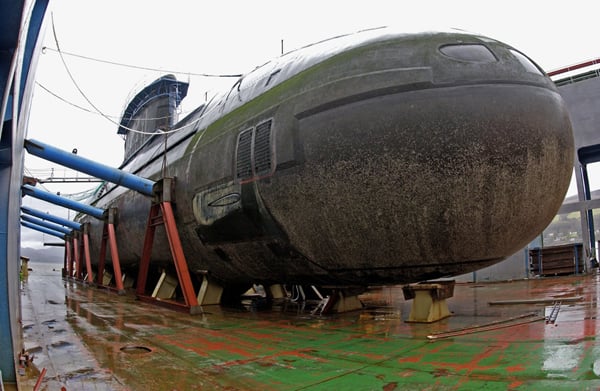Peter MacKay looks after himself by playing manly sports and dressing sharp. His efforts have impressed a string of beautiful and accomplished women, including his talented new wife Nazanin Afshin-Jam.
But the Canadian defence minister's drive for social success seems to be motivated by a certain personal insecurity. He requires ego boosts from his staff, freezes up in the presence of true celebrities, and shows up his closest friends by arranging for a military helicopter to winch him away from a fishing resort.
Now, MacKay's insecurity could be linked to his subordinate relationship with Stephen Harper, or perhaps some lingering guilt for having broken a written agreement with David Orchard in order to make Harper leader of the Conservative Party. But we suspect the problem is more directly connected to one of MacKay's ministerial responsibilities, namely Canada's troubled fleet of second-hand diesel-electric submarines.
The best part of any defence minister's job is the kit: the fighter jets, tanks, destroyers and rockets that most of us only ever see in movies. And in this boyish fantasy-turned-reality, nothing quite matches the high technology and suggestive power of the submarine. The tigers of the sea, submarines are silent, deadly, and virile.
Up periscope!
The symbolism has been reaffirmed in numerous movies. For half a century, Hollywood has assigned the hunkiest of leading men to the submarine genre. From Rock Hudson standing up to the Soviets in Ice Station Zebra to Clark Gable and Burt Lancaster taking on the Japanese fleet in Run Silent Run Deep, submarine commanders require courage, intelligence, and muscly good looks. Submarines bring out the best in a man, giving emotional depth to Charlton Heston's character in Gray Lady Down, and turning Sean Connery from the shallow and morally supple James Bond into an introspective and principled Soviet submariner-turned-defector in The Hunt for Red October.
It took Matthew McConaughey to capture the Enigma code machine in U-571 and win the Second World War. It took Harrison Ford to stop a reactor meltdown in K-19 that would have turned the Cold War into a full-blown nuclear holocaust. And even McConaughey and Ford could not match the testosterone levels generated by Gene Hackman and Denzel Washington in Crimson Tide.
Just imagine how Peter MacKay feels up against that line-up. When MacKay was appointed defence minister in 2007, the top file on his desk concerned four derelict submarines the British Royal Navy had offloaded on Jean Chrétien's government in 1998. Disparaged by the media as the "Sea Kings of the Sea" and "Deep Sea Duds", the vessels had already experienced a litany of problems by the time MacKay came along.
Age takes its toll
Many of the problems were related to the fact that the submarines had languished in salt water for four years awaiting a buyer, and another two to six years before Canada actually took possession of them. They suffered serious corrosion as a result, to the point where the diving depth of HMCS Windsor remains limited to this day.
Other problems occurred after the submarines passed into Canadian hands. In 2004, a fire broke out on HMCS Chicoutimi, leading to one death and numerous injuries. The fire resulted from an electrical short, caused by a combination of seawater entering through an open hatch and wiring that had just "one layer of waterproof sealant instead of the three layers that British navy specifications required."
That same year, "catastrophic damage" was done to HMCS Victoria after a new $1-million on-shore electric source proved incompatible with on-board equipment that, according to the Halifax Chronicle Herald, "probably goes back to the '60s."
Despite knowing about these problems, the allure of smooth-functioning submarines overrode any rational decision-making. "I want to see those subs fully operational as soon as possible,'" said MacKay. "The project has always had my support... and they're going to be a great addition to Canada's navy."
Performance problems
In 2008, MacKay persuaded his cabinet colleagues not to scrap Canada's submarine program. Instead, they approved a $1.5-billion refit and repair contract with a British-based defence company, Babcock International Group. MacKay was thus responsible for committing taxpayers to a continuation of an already failing procurement involving submarines that were clearly and badly flawed.
Moreover, the submarines were by that time already 15 to 19 years old -- meaning that the most one could hope for, after their refits, was a single decade of service. The decision to spend the $1.5 billion is all the more perplexing when one considers that, for the same amount, the government could have procured three or four brand new diesel-electric submarines, based on proven designs from France or Germany.
For this reason, it seems that something more than regular "submarine envy" has motivated MacKay's decision-making. The defence minister may, in fact, be attempting a more ambitious and strategic long game.
As any reasonably informed person could have expected, the travails of the submarines would continue. For example, in 2012, HMCS Windsor completed a refit that was initially scheduled to take two years, but ultimately took five years due to numerous problems being discovered. According to documents obtained by the CBC: "It appears that every system... has major problems... including bad welds in the hull, broken torpedo tubes, a faulty rudder and tiles on the side of the sub that continually fall off."
And after HMCS Windsor was re-launched, a defect was found in one of its two diesel engines. As a result, the vessel's diving depth had been "severely restricted and the navy has been forced to withdraw the sub from planned exercises off the southern U.S. coast."
Another foreseeable challenge has been a shortage or lack of spare parts. As Commander R.E. Bush, the project director for the submarine program explained back in 2005, "many of the original equipment manufacturers either no longer manufacture the equipment, or have moved on to other designs."
According to the Navy, the four-vessel fleet has accumulated a total of just 1131 days at sea in the decade since 2003. This works out, on average, to about 30 days per submarine per year.
'In an ideal world'
It is therefore hardly surprising that the Navy is now gently expressing a desire for replacement submarines. In May 2011, Murray Brewster of the Canadian Press reported on a briefing note that had been prepared for then Chief of the Defence Staff Walter Natynczyk: "Planners say the country will likely need bigger, quieter boats that can perform stealth missions, launch undersea robots and fire guided missiles at shore targets."
In October 2011, when asked whether the government might look at replacing the current vessels, Peter MacKay said that submarines provide a "very important capability for the Canadian Forces." Significantly, he went on to say: "Well there was a position taken some time ago to go with diesel-electric. But you know, in an ideal world, I know nuclear subs are what's needed under deep water, deep ice."
Now, here's the thing. In the last few years, the U.S. Navy has begun decommissioning its Los Angeles-class nuclear-powered attack submarines, and it might conceivably wish to be sell several of them to Canada. The Los Angeles-class is a truly awesome machine with a top speed of 27 knots, an almost indefinite range, and the ability to launch both torpedoes and cruise missiles. Later models of the class, which could become available in the next five to 10 years, are specifically designed for operating under Arctic sea-ice.
On top of all that, a Los Angeles-class submarine featured prominently in The Hunt for Red October. Scott Glenn, who played the captain of the USS Dallas, also starred as macho astronaut Alan Shepard in The Right Stuff.
But let's face it: Peter MacKay is unlikely to remain as defence minister for another five to 10 years. Indeed, he could be shuffled out of the defence portfolio later this month.
MacKay is thus destined to remain the Canadian equivalent of Kelsey Grammer of Frasier fame, who in Down Periscope is given command of an ancient diesel-electric submarine and charged with evading the entire U.S. fleet during a war game.
Grammer and MacKay's submarines are, in fact, remarkably similar. Their sole advantage lies not in size, power and virility, but in sheer inconspicuousness. For while the submarines are small, decrepit and prone to malfunctions, the diesel-electric engines make them difficult to detect. They are thus truly useful for just one purpose: helping others -- in this case the U.S. Navy -- practice for the real thing.
The lesson, we humbly suggest, is simple. Instead of longing for more size and power, Peter MacKay should adopt a sense of humour -- and make do with what he's got. ![]()
Read more: Federal Politics
















Tyee Commenting Guidelines
Comments that violate guidelines risk being deleted, and violations may result in a temporary or permanent user ban. Maintain the spirit of good conversation to stay in the discussion.
*Please note The Tyee is not a forum for spreading misinformation about COVID-19, denying its existence or minimizing its risk to public health.
Do:
Do not: